A large part of my working life was dominated by the typewriter. The klack (sic) of the keys dominated all my various offices. I was in my early forties when electronics first intruded on an office life that had changed very little in the previous century. We were still writing in ledgers, typing letters (with carbon paper and a “flimsy” sheet to record for posterity) and keeping records on little filing cards. At the time, I loved my typewriters, just as I now love my computers, my automated systems and, of course, my digital cameras.
Now, of course, most people have used computers all their lives. They have little idea of what it was like to type one copy, hoping for no serious mistakes, which would mean starting all over again. And with no realistic expectation of incorporating revisions or improvements. You had to get it right first time. Now, we revise to our heart’s content before issuing a document. And, in most cases, documents are never printed.
Yet, there is just something satisfying about using a manual typewriter, and I’ve been suffering withdrawal symptoms for several decades. Today’s computer keyboards, especially the Apple Magic Keyboard which I use, are virtually silent. And the key travel is measured in millimetres rather than inches as on the old typewriter. To assuage this long-lost tactile and audiological deprivation, I perform regular exercises.
Klack: Typewriter lore
I keep an assortment of functioning typewriters in my study. There is a brace of Olympia semi-portables, the early 1950s SM2 and the more streamlined 1960s SM8, plus one of the most popular true portables, the Olympia Traveller De Luxe (which started production in 1969). Then there is my favourite portable of all time, the Olivetti Lettera 32. It was produced from 1963 and was once described as “one of history’s most beautiful writing machines”. Sadly, mine has lost its front badge. But it continues to work with precision and provides one of the most satisfying typewriter clickety-clack experiences imaginable. With its svelte profile and zippered faux-leather carrying case, the Lettera 32 was my constant companion on business trips before the arrival of the laptop computer.

Interestingly, my stable of typewriters gives me a choice between the two major systems of “shift”. Pressing the shift key on a mechanical keyboard causes the capital letter section of the type-bar to hit the paper instead of the regular lower case. It’s how this is achieved that matters.
The two systems of shift
There is the original carriage shift where the shift key raises the heavy carriage to meet the capital letters, and there is basket shift where the type basket itself lowers to achieve the same effect. Basket shift is much to be preferred because the shift action requires far less effort. Furthermore, it is more precise, with less chance of misalignment. Raising the heavy carriage is much harder work. And there is a danger of misfire — when the capital letter is misplaced on the line.
Basket case
Unusual in such a small machine, basket shift is standard on the little Olivetti Lettera 32. It is one of the reasons I preferred this machine over the Olympia competitor, the Traveller De Luxe, which uses the older carriage shift system. Of my two semi portables, the older SM2, features (a very heavy) carriage shift. The newer SM8 has graduated to the improved and much lighter-action basket shift.
Every week, I lift one of these rather heavy machines from its shelf and spend a glorious fifteen minutes pounding away. Time-honoured sentences such as “the quick brown fox jumps over the lazy dog” and “now is the time for all good men to come to the aid of the party” exercise most, it not all, keys and all the fingers and bring a tear to my eye. Nevertheless, I still lust after a grown-up “standard office” typewriter, especially one of the later Olympia SG3s or the lust-worthy Hermes 3000.
These monsters were the pinnacle of mechanical typewriter technology. But, even if I were to acquire one, I really don’t know where I would put it. These things are big. And heavy. And, sadly, many of these heavy-duty machines were destroyed as offices changed over to electric typewriters or, eventually, computers. Portables, such as Olivetti and Olympus models, have survived in far greater numbers because they were mostly in private hands.
The office-standard manual typewriter faced extinction in the late 1960s with the popularity of electric-powered machines, in particularly the revolutionary IBM Selectric with its futuristic interchangeable “golf ball” type head.
The Klack of the “Office Standard”
At the age of just 19, I was exposed to the “office standard” when I started work as a journalist on Britain’s leading national motorcycle magazine. Our office in Dorset House, near London’s Waterloo Station, hadn’t changed much since the early thirties. The mouldering and rather smelly antique Bakelite telephones were standard fare. As were the battered wooden desks and the ranks of dark-green utility filing cabinets. Carbon paper and flimsy paper were our stock-in-trade, with the top copy going to the printers and the carbon copy being filed for future reference.
Here is a little ditty composed by one J.W.Mattucks (né William S) printed in a local newspaper in Robinson, Kansas, in 1895:
It’s “clickety click, clickety click,” / Till the very sound of it makes me sick; / “Clickety click” from morn till night / And then in my dreams until broad daylight / “Clickity click,” my living to win, / Till my finger tips are all worn thin: / “Clickity click,” till my brain’s a whirl — / So sang a pretty typewriter girl. / “Clickity click,” with the senior pard / Eyeing me over his spectacles hard / “Clickity click”, with the junior pard / Whispering “really don’t work so hard;’ / “Clickity click” till my eyes are blurred, / And I scarcely see of my notes a word, / Till my frizzes droop and my bangs uncurl, / And I wish there was never a typewriter girl. / “Clickity click” is the only song / That rings in my ears through the days so long; / “Clickity click,” though the heart may ache, / Still the weary fingers no rest may take. / “Clickity click,” the machine must go, / If one girl dies there are others you know; / But when I’m dead, on my tombstone stick / These words, “She died of the clickity click.”
J.W.Mattucks, 1895 (alternate spelliing of clickety / clickity down to Mr Mattucks’s inconsistency, not ours)
The above quotation comes to us via Type-writer.org where you can see a facsimile of the original.
Our collection of typing artefacts
The tops of these cabinets in my office were occupied by a fantastic collection of, mostly ancient, typewriters. Some of them dated back to before the First World War and hardly any were of post-WWII provenance. They were truly antebellum artefacts. There were many Imperials, Underwoods and Royals, and even one fascinating Remington Noiseless, which had featured an unusual and small type basket with all type bars very near to the paper. There was much bodywork to cut down on sound. I was spoiled for choice. My favourite, which I snaffled for my desk, was the Olympia SG3, perhaps the only modern post-war machine in the entire office. It was a paragon of typing perfection, compared with the haphazard results produced by most of the earlier machines.
As a journalist, I was unusual among men in being a proficient typist at an early age. At that time, typing was regarded as a female pursuit. Every man in business had a secretary to type his letters and make his tea. More junior gentlemen had access to the “typing pool” which consisted of rows of women sitting at little typing desks, copying shorthand or listening to antique Dictaphones.
Long before that, however, the typewriter was hailed as a wondrous invention in the 1870s. A flavour of the excitement surrounding the invention can be tasted in this extract printed in Dublin in 1877:
We are indebted to a London contemporary for a description of a new and wonderful machine named the “type-writer”, and we can only exclaim, “what next!” The telegraph was a wonder, and is a wonder still; the sewing machine was another marvel; the type-composing machine amazed us next, and then came the telephone to startle us…. With Babbage’s calculating machine perfected, and the “type-writer” complete and in working order, there is only one more invention to smash this shivering universe into “smithereens.” Who will win the laurel by inventing a “thinking machine”? Who?
The Irish Builder, Dublin, October 1, 1877
Again, you can see a facsimile of this original article from 146 years ago (but with much more detail) here at Type-Writer.org.
The QWERTY question and the speed of Klack
Now, of course, every young person soon becomes a proficient typist. What is remarkable, though, is that despite the progress of technology, we are still using the same keyboard layout Christopher Latham Sholes developed for what became the Remington typewriter in 1873. Legend has it that the keys are arranged in a fashion that favours the most commonly used letters in the English language.
Others believe, probably with better reason, that the letters are jumbled up to discourage fast typing that would have caused mechanical clashes in those early typing machines. Who knows, but QWERTY remains as a modern shrine to the inventiveness of the 19th Century pioneers. I still fondly pronounce the keyboard as qwerty uiop asdefugikal zuksvebenum. It’s a sort of Lorum Ipsum for the age of the typewriter.
The little duck
Strangely, there is one character that was thought essential on the first typewriters and which fell into disuse gradually throughout the 20th Century. Initially used in accounting and in bill preparation, the little @ — as in “12 eggs @ 1d each = one shilling” — was all but redundant by the late 1970s. I often wondered why typewriter manufacturers didn’t think of something more useful to fill the precious top row above the numbers. Then email came along, and the little “at” gained a whole new life. The resurrection of @ is a saga in its own right.
“@”, though, makes real sense only in English. In other languages, it frequently has a name of it own. My favourite is the Greek usage, where @ is commonly called the “papaki” or duckling. That’s because it looks like a little duck, and it’s as good a reason as any. So I can be contacted on Mike duckling Macfilos.com. In your travels you might also come across @ as little worm, spider monkey or moon’s ear. See this BBC expose of more versions of @.
Those were the days…
All this pure nostalgia, of course. I wouldn’t swap my Mac, iPads, and iPhones for a mechanical typewriter, landline telephone or handwritten journal. Everything I could do in my entire office can now be accomplished on an iPhone, from bed if necessary, far quicker and more efficiently. Rose-tinted glasses can do only so much. But I do pine for those days of physical, tactile contact and the encouraging noises that typewriters made. The boss certainly knew you were hard at work, even from the next office. No chance of a bit of time on Facebook, even if such wonders had existed.
Another curiosity from my collection, again in need of a service and some spare parts. The Corona was one of the first truly successful portable machines, featuring a strange folding design so that it could fit into its leatherette-covered wooden box. This particular model was made just before or just after the First World War. On the front it bears a “Factory Rebuilt by L.C. Smith & Corona” but without a date.
Klack of the typewriter sounds again
All that is left of the quintessential office machine of the 20th century, the typewriter in all its guises, is the sound. Clickety clack.
With this in mind, I have just discovered a way of persuading Apple’s Magic Keyboard to simulate the sounds of the old typewriters. Klack is a native macOS application that adds keyclicks as you type. At first, the clicks are definitely heard to come disconcertingly from the speakers in the monitor, rather than from the keyboard itself. But after a month of fast typing, I no longer notice this dissonance. My senses have been persuaded to imagine the clicks and clacks are emanating from the keyboard itself. Perfect!
How you get the knack of the klack
One thing Klack cannot do is emulate the (with hindsight) enormous key travel of an old manual typewriter. The keys drop by around one inch as the type bars rise to strike the paper resting on the platen. This long travel is perhaps the least appealing part of using a typewriter, as are the frequent clashes of type bars if you type too erratically. No, I can manage without that. But I am now fully addicted to Klack. I can thoroughly recommend it to nostalgic types who spent their formative years pounding away on old machines.
While this article is a little off subject, I hope readers will find it a fun read at the start of 2024. Happy New Year to all our readers.
What about your experiences with the old mechanical typewriter? Can you tell tales of pounding on the keys, frustration over typos (and wielding of the Tipp-Ex bottle containing that liquid white magic)? Or, maybe, you still hold “carbon copies” of articles, theses, and letters from decades ago. Let’s discuss…
You can find Klack in the macOS App Store or download it here.
Read more on typewriters on Macfilos
If you are interested in the world of typewriters, pay a visit to Type-Writer.org.
Join our community and play an active part in the future of Macfilos: This site is run by a group of volunteers and dedicated authors around the world. It is supported by donations from readers who appreciate a calm, stress-free experience, with courteous comments and an absence of advertising or commercialisation. Why not subscribe to the thrice-weekly newsletter by joining our mailing list? Comment on this article or, even, write your own. And if you have enjoyed the ride so far, please consider making a small donation to our ever-increasing running costs.

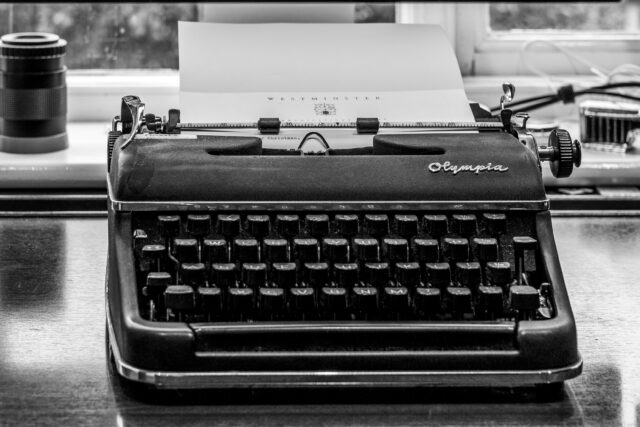
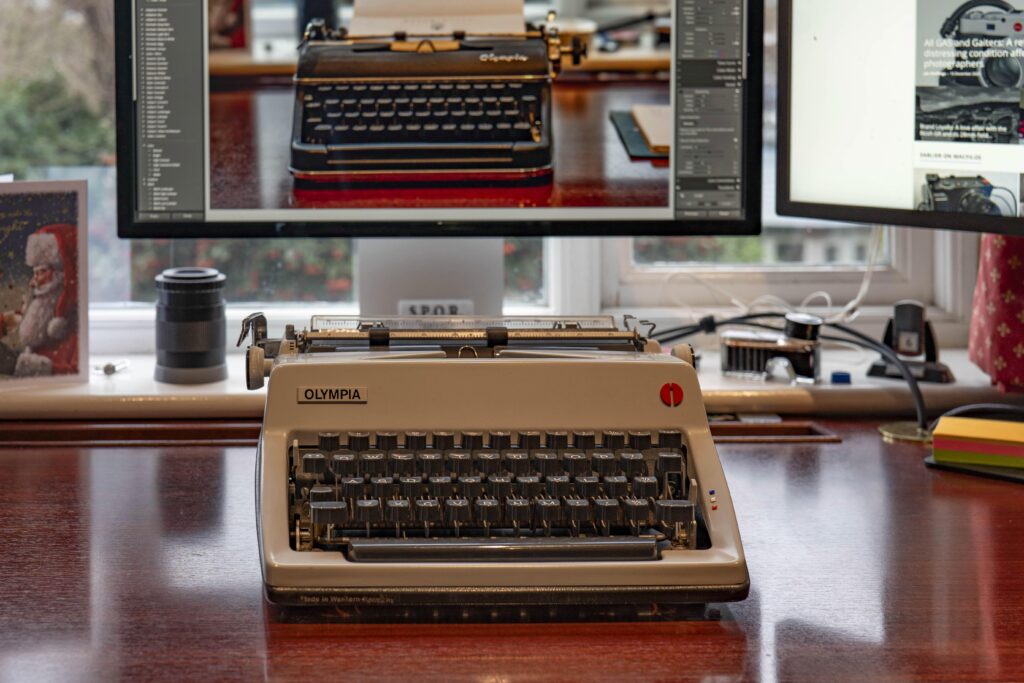


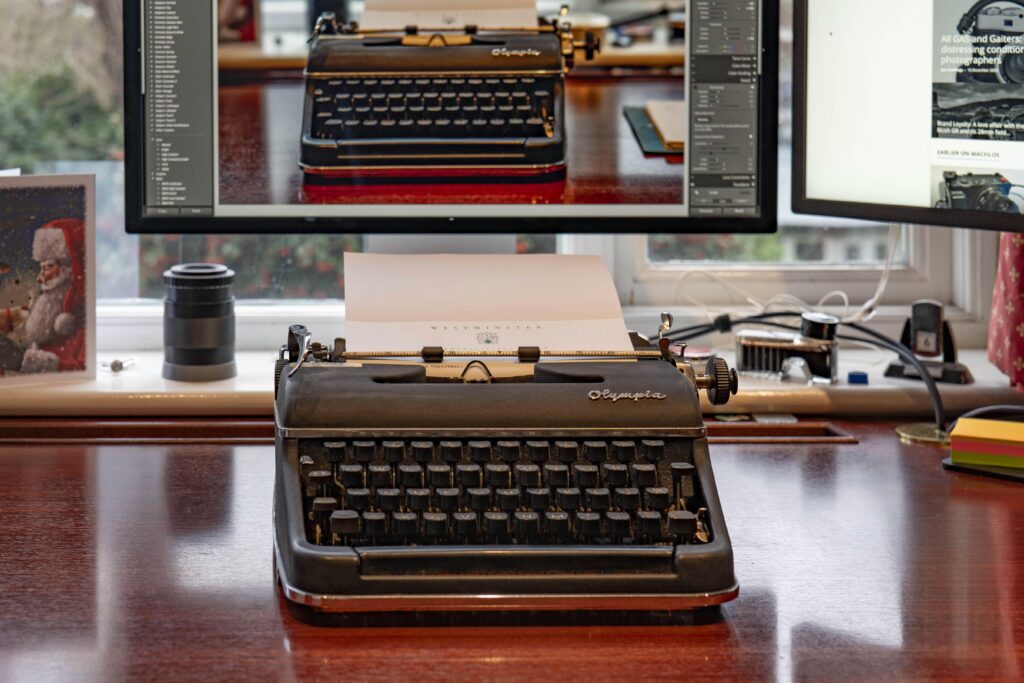
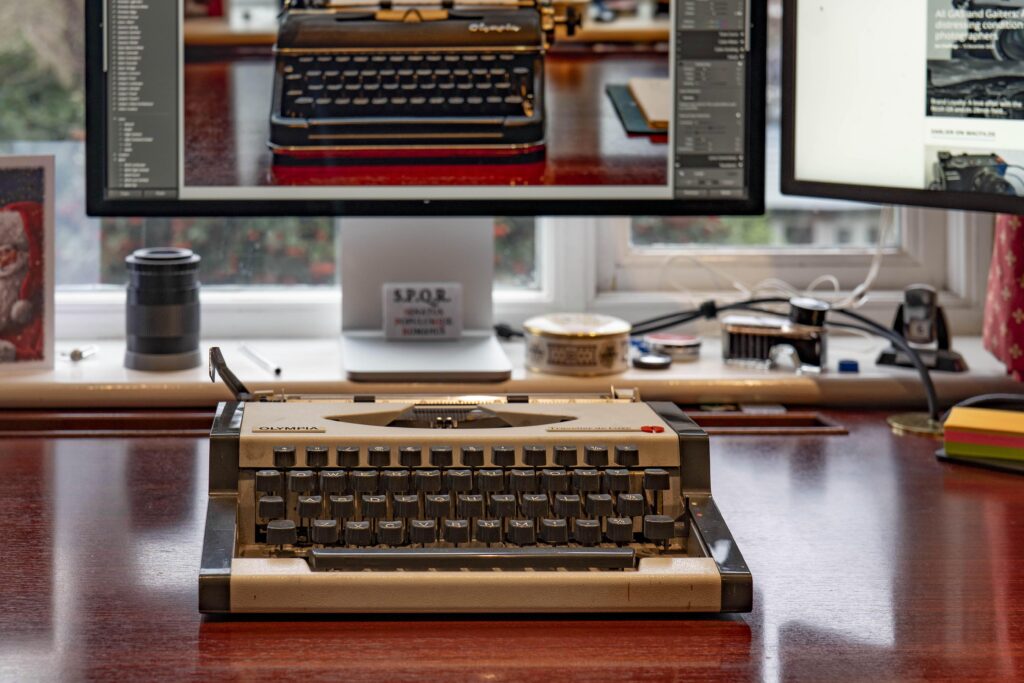
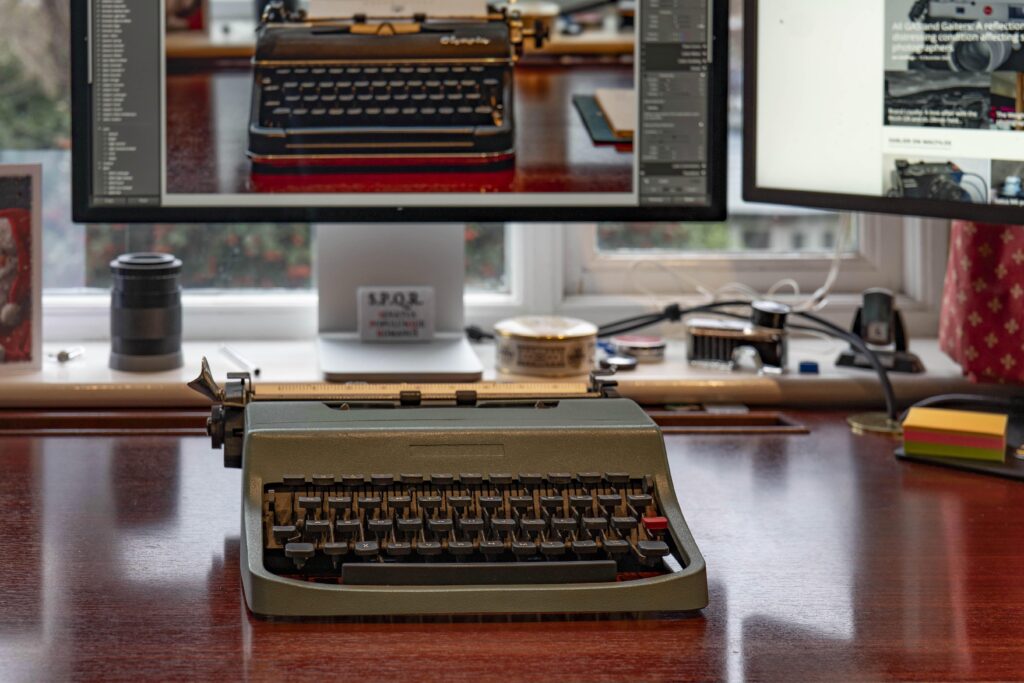
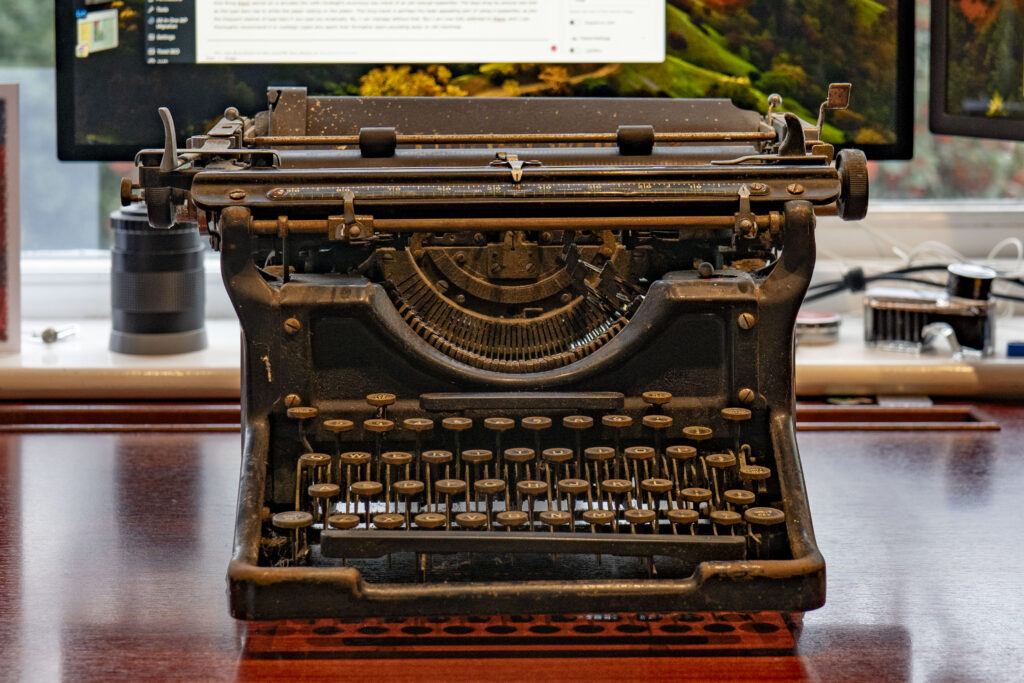






Surely you must own a mechanical keyboard or two. For those of us who love the feeling of typing, they are a wonder.
Strange to say, I have never bought one of the mechanical computer keyboards. I was tempted many years ago by Das Keyboard and the like, but never succumbed. For work, I now prefer a modern keyboard, but then Klack Klack provides a more tactile impression.
During the war, my mom was an executive secretary — much as you describe, not part of the typing pool. Of course, after the war, returning men needed jobs, so she lost that position — but kept the typewriter; I played with it as a child. And of course, when I left for University, she bought me a Hermes portable (the green one) for typing my papers.
I confess to falling for the charms of the IBM Selectric: one of the type balls had math symbols!
Great stuff. I learned to type on an Olympia Traveller de Luxe before ‘investing’ in an electric Smith & Corona in the days just before PCs became more commonplace.
These days, I get my fix from a pair of beautifully restored typewriters: a Brother De Luxe and a sought after Hermes 3000.
George Blackman, or Mr & Mrs Vintage, specialise in cleaning, repairing and restoring vintage typewriters to full health and often have some wonderful models in stock.
In a digital world, there is definitely something very satisfying about producing a letter or quick note in this way…not unlike shooting with film and making prints I suppose.
Thanks, Andrew. I will make a note of the two experts you mention I forgot to mention one area where the typewriter still reigns supreme — entering data into forms.
Ah! The Hermes 3000. I am a similar shade of green with envy. I want one, but I’ve reached the stage where something else would have to go to make room on the shelves.
Clicker Klack of individual typewriters or the chatter of a typing pool l remember them well as also the chunking of Linotype in newspaper offices which according to my late Mum was very similar to her experience with the Enigma machine she used when called up to the Luftwaffe during WWII similar to the example at Bletchley Park
https://share.icloud.com/photos/0b16nsUGnvXp8VsBMe5u17xKA
As for duplicating machines remember getting quite a high on meths
Your mother used an Enigma? Wow, I’m impressed.
I was aware that an Enigma had been purloined from a captured U-boat, but I believe this was after the code had already been broken by the brute force method at Bletchley Park?
Mike
An interesting comment thank you. The machine in the photograph shown in the attached link is in fact an TS2 teletypewriter.
From Wikipedia: “The Siemens & Halske T52, also known as the Geheimschreiber (“secret teleprinter”), or Schlüsselfernschreibmaschine (SFM), was WW2 cipher machine and teleprinter made by the electrical engineering firm Siemens & Halske.
While the Enigma machine was generally used by field units, the T52 was an online machine used by Luftwaffe and German Navy units, which could support the heavy machine, teletypewriter and attendant fixed circuits.”
This is probably the cipher machine most used by the Luftwaffe.
Chris
Don’t you just love German? Schlüsselfernschreibmaschine indeed! But what about the Schlüsselfernschreibmaschinebediendersstuhl? Can any of our German readers expand it — or even sit on it? Dreaming up improbable but lengthy compound words such as these used to be a popular hobby. I remember one concerning the Cologne-Düsseldorf-steam-ship-company’s-captain’s-hat-badge. All one word, of course, but only for fun.
Schlüsselfernschreibmaschinebedienerstuhl
Schlüsselfernschreibmaschinebedienerstuhlpolsterer
Schlüsselfernschreibmaschinebedienerstuhlpolstererlehrling
and so on
This is an excellent word for “gallows guessing”, a word game which I used to play with my grandma.
Greets Dirk
I cut and pasted the first compound word into Google Translate. It came up with Key teletypewriter operator chair. But the other two choked it. It asked “Did you mean ____ ? and separated the compound word into parts. So doing, it translated the second to Key Teletypewriter Operator Chair Upholsterer. The third, it refuse to do at all.
We use a grammar checker called LanguageTool which is of German provenance and handles many languages well, including of course English. It gives a resounding “correct” to all these constructions.
The last one means:
teletypewriter operator chair upholsterer apprentice
The most important issue with putting nouns together is that any German will understand what’s meant.
I always think German is (or was) a pure language in comparison with the ultra-promiscuous English mongrel, which will go anywhere and do anything for a new word. German constructions such as wire word (telegram), distance viewer (television), and distance speaker (telephone) are so descriptive and easy to understand.
In this particular instance, we have “distance writer” in German, when Americans (or was it the British) came up with an entirely new word, telex. Sadly, this purity is disappearing from German under pressure from the baleful influence of English. “Fernsprecher” and “Fernseher” seem to have given way to Telefon and Tee-Fow (television) and there are many more instances.
Long may the distance-writer-operator sit on his chair.
Now, remind me what we were talking about earlier…
“..distance viewer (television), and distance speaker (telephone)..” ..those seem just as descriptive in English (using a bit of Greek and Latin too) as in German.
‘Distance’ = tele (“the Greek adjective tēle, meaning “far off” says Merriam-Webster, the dictionary people) ..we photographers recognise that in ‘telephoto’ ..then add Tele to ‘Vision’ (“..the root vis comes from a Latin word that means “to see” – says Merriam-Webster again).
So ‘Tele-Vision’ – ‘far seer’ ..pretty much the same as the German ‘Fernseher’ ..no?
I suppose purity, like beauty, is in the eye (or ear) of the beholder. I don’t know German, but find it fascinating that the simplest German sounds a lot like English. Old German, I suppose, is from whence English came. Yet complex German does not sound at all like English.
Speaking of borrowing, Japanese historically borrowed from Chinese, but in modern times from English. It seems to me (and again, I don’t know Japanese) that rather than translate, it simply creates a Japanese word that is phonetically similar to the English word.
Borrowing words from other languages…
In German these are Lehnworte, loanwords tells me my translating program.
Maybe there are more such words from English in German than vice versa. But you all know kindergarden, angst, blitzkrieg and so on. German is full of Latin words, like Fenster, fenestra.
Using English words is a common trend; language is alive.
Using old German words puts you in the archaic, right wing corner, especially if you insist in correct grammar and use all four cases.
And at the end English and German are very closely related languages, with Dutch and lower German in between.
…and one of my favourite German loan words, Schadenfreude, which has no English equivalent and is now as common as Angst and Kindergarten.
Fascinating and interesting! My father had two typewriters, an old olive-drab L.C. Smith with the round keys, and a more modern one that I forget the name of, but he always preferred the former.
I never learned to touch type. I always wrote out my essays and term papers in grade school and college. I knew others who paid typists to do their papers in college, but was too cheap. That was the late 1960s, and I never had a professor who insisted on typewritten papers.
Fast forward to the late 1970s, and I am in graduate school, with a wife who is a skilled typist, and we decide I should be submitting papers typewritten. Being in engineering, certain scientific symbols are needed! Enter the Smith-Corona Coronamatic. It used a quick-change cartridge ribbon, and a separate correction ribbon. But the pièce de résistance was four of the keys had changeable typefaces, including many available symbols! How advanced it seemed. That typewriter is long gone, but the wife remains!
I have one employee who loved the IBM klickety-klack keyboards, which with the large round plug became obsolete many years ago. But you can still buy the key-switch keyboards for modern PCs.
Yes, typewriters are a fascinating subject. There are several blogs devoted exclusively to typewriters, believe it or not. Glad to hear you didn’t send the wife off to eBay.
Mike
Again after reading the MacFilos entries I am reminded of some event or other, and here the mamory is buying a typewirter, which may have been an Underwood, a full size office model, for 4/6 (four and six, in old money, four shillings and sixpence) at a jumble sale, and sort of learing to type but I never gained anywhere near a touch typing skill. The typewriter in in the loft somewhere, placed there in the early 1980’s some years after marriage and moving to our home, where it remains to this day.
At a time a little later, before computers, I purchased an Erika Model 170 typewriter for £124 (I still have the invoice!), intending to write professional correspondence to support my status as self employed, but sadly this venture did not last very long, and the Erika fell into disuse, and remains in in a cupboard.
My typing skills have never got much beyond what is known as pecking style, despite trying to use all my fingers, and now using computer keyboards.
Thank you, Mike, for your nostalgic trip to the times of the typing pools which generated a fair background sound of unsynchronised ‘clacking’.
My first typewriter was an Underwood portable which came with a neat wooden case for travelling. I bought it from a junk shop for six old pence, for the purpose of learning to type. More than a decade later I bought a new Imperial Good Companions portable, in a leather case, on which I learned to touch-type. With a deadline of a thesis to write, I worked through a 16-page self-instruction manual in a weekend. By Sunday night I could touch type most keys except the top row of numbers and symbols. That industrious weekend certainly helped my transition to a computer keyboard.
Whatever happened to the legions who manned the typing pools? Wishing you all a Peaceful New Year.
Mike
Yes I agree. This is a fun article to start the New Year, so, Happy New Year to you and all readers of Macfilos.
My wife has just been reminiscing about the time at her boarding school where she learnt to touch type as part of a secretarial course. A Miss Whittaker, a strict disciplinarian, used to beat out, “a s d f g ; l k j h” to the sound of a ruler hitting the desk. Faster and faster the routine went. The typewriter keyboards were covered, so there was no looking down. Woe betide anybody who made a mistake. Tipp-Ex was not allowed. Just do it again. Needless to say this skill is still invaluable to my wife today.
How did you learn to type?
Chris
I taught myself, as I have done most things in my life. I read books which told me now to position my fingers and then typed and typed until I had bukt up a good speed. I’m probably not as accurate as a trained secretary, however, so I appreciate modern computer composition more than most typists, I suspect.
“..“12 eggs @ 1p each = one shilling”..” ..what?!
Mike, your mind’s going! Try ““12 eggs @ 1d each = one shilling”.
And as for typerwiters (see what I did there? ..no auto-correct on a tripewriter, till maybe those Philips electric self-correcting machines came along) ..I, too, used a little lightweight Olivetti in my rôle as Tech Editor on ‘Practical Photography’ (..I can’t call it a ‘job’, as I was simply paid to have fun and write whatever I wanted for three years!..) and it was, as you say, a delightful little machine ..and, when I left, I was given it as a leaving ‘good luck’ gift. (I don’t have it now, as my father took a liking to it – not surprisingly – and he, er, adopted it.)
That flackery-clack (oops, another typo ..where’s the Tippex whiter-outer liquid? – but that would have done no good on a Roneo or Gestetner duplicating machine, to correct the ‘template’ was it called? ..that flimsy paper-y material one typed on, and which created the original sheet from which umpteen copies could be run off by turning that big crank handle..)
Tom Hanks collects tyrepipers, too: tinyurl.com/Typewr1t1ng ..it’s a tactile thing, and the sound (..the raucous noise of London’s ‘Evening Standard’ journalists’ floor..), and the physicality of the machinery of expressing – or, in truth, pressing – words onto paper.
Gone, but certainly not fogotten (darn; done it again) and is there anyone who could ever forget Leroy Anderson’s ‘The Typewriter’? youtube.com/watch?v=g2LJ1i7222c
David,
You are quite right and silly of me to use “pee” instead of d. I stand corrected. Don’t get me started on duplicators and the typewriter templates. “Cutting stencils” was a daily chore because all our clients’ press releases had to be typed onto stencils, run through the duplicator (I was a Roneo addict), with most of the ink ending up on my hands. Then the copies had to be collated, folded and mailed. Aaaarrgh! These days, Leica and every other company send their press releases by email (and a lot less work that must be).
I think I’ve written before about Tom Hanks’s typewriter addiction, and I even have a Tom Hanks typewriter app somewhere on my Mac or iPhone. Must find it.
Thanks for this reminder of what life used to be like. In the Cheffings household as a child, Saturday mornings meant the door to the Reverend’s study was closed and all you could hear was the clack-clack of the typewriter (a Chinoise green Olivetti of uncertain model) as the following day’s sermons were finally being written. Occasional pauses were taken to reflect, drink copious quantities of tea or to check biblical references before the clack-clacking resumed. Hours later the Reverend would emerge with separate neatly typed sermons for Sunday morning and Sunday evening. More tea was then consumed before the clack-clacking signified new pages replacing old in the editing and refining process. At that point silence…The Word had arisen!
Thanks, Jon, for adding an ecclesiastical note… Revising a document (that is, retyping it) was a true labour of love. My grandfather, a grocer but a would-be author, bequeathed several wartime essays to me. They were all typed on flimsy paper (some of it greaseproof because he was a grocer) and covered in brown paper. During the war, you had to use what came to hand. Significantly, however, there are numerous versions of every story. He must have read through his first efforts, found a few typos or had further thoughts, and then went through the process of typing the whole essay again before stapling it into a new brown-paper cover. Such dedication.
Thank you, Jeff. It’s good to wallow in nostalgia occasionally. But, for all the perceived problems of technology, the ability to produce good documentation is one benefit we would not be without.
Hi Mike, thanks for a delightful start to 2024. What better way to begin a new year than being reminded of how much life has changed, year-by-year, over a lifetime. I typed up various research projects, and eventually my thesis on a mechanical typewriter. Much use of ‘tip-ex’ and correction tape was made in order to produce an error-free final version. I tried to get some help from a secretary, but the highly technical nature of the material meant that she made more errors per page than I did! I am very envious of your collection! Thanks again for a lovely article and a fun start to the year. All the best, Jeff.